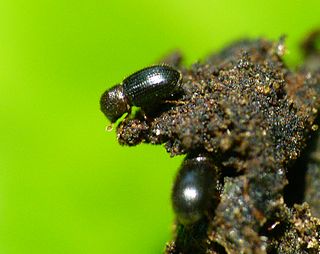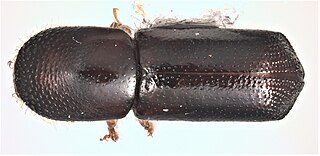
Catopsis berteroniana, commonly known as the powdery strap airplant or the lantern of the forest, is an epiphytic bromeliad thought to be a possible carnivorous plant, similar to Brocchinia reducta, although the evidence is equivocal. Its native range is from southern Florida to southern Brazil. It generally grows on the unshaded twigs of trees, and has been shown experimentally to trap more insects in its tank than other bromeliads of comparable size. There are several other species in the genus, none of which is believed to be carnivorous.

The palm weevil Rhynchophorus ferrugineus is one of two species of snout beetle known as the red palm weevil, Asian palm weevil or sago palm weevil. The adult beetles are relatively large, ranging between 2 and 4 centimetres long, and are usually a rusty red colour—but many colour variants exist and have often been classified as different species. Weevil larvae can excavate holes in the trunks of palm trees up to 1 metre (3.3 ft) long, thereby weakening and eventually killing the host plant. As a result, the weevil is considered a major pest in palm plantations, including the coconut palm, date palm and oil palm.

The leek moth or onion leaf miner is a species of moth of family Acrolepiidae and the genus Acrolepiopsis. The species is native to Europe and Siberia, but is also found in North America, where it is an invasive species. While it was initially recorded in Hawaii, this was actually a misidentification of Acrolepiopsis sapporensis.

Anthonomus eugenii is known as the pepper weevil. This beetle feeds and lays eggs on plants in the genus Capsicum and a few species in the genus Solanum. A. eugenii is native to Mexico, however, it is an important pest of Capsicum in Florida, Puerto Rico, and Central America.

Hypothenemus hampei, the coffee berry borer, is a small beetle native to Africa. It is the most harmful insect pest of coffee worldwide. Spanish common names of the insect include barrenador del café, gorgojo del café, and broca del café.

Cyrtobagous salviniae is a species of weevil known as the salvinia weevil. It is used as an agent of biological pest control against the noxious aquatic plant giant salvinia.

Cyphocleonus achates is a species of true weevil known as the knapweed root weevil. It is native to southern Europe and the Mediterranean and is used as an agent of biological pest control against noxious knapweeds, especially spotted knapweed. It has recently been spotted in India.

Xyleborus glabratus, the redbay ambrosia beetle, is a type of ambrosia beetle invasive in the United States. It has been documented as the primary vector of Raffaelea lauricola, the fungus that causes laurel wilt, a disease that can kill several North American tree species in the family Lauraceae, including redbay, sassafras, and avocado.

Tillandsia fasciculata, commonly known as the giant airplant, giant wild pine, or cardinal airplant, is a species of bromeliad that is native to Central America, Mexico, the West Indies, northern South America, and the southeastern United States. Within the United States, this airplant is at risk of extirpation from the Mexican bromeliad weevil, Metamasius callizona. A related plant, Tillandsia utriculata, sometimes called the "wild pine", is endemic to the same areas.

Tillandsia utriculata, commonly known as the spreading airplant, the giant airplant, or wild pine is a species of bromeliad that is native to Florida and Georgia in the United States, the Caribbean, southern and eastern Mexico, Central America, and Venezuela.

Anastrepha ludens, the Mexican fruit fly or Mexfly, is a species of fly of the Anastrepha genus in the Tephritidae family. It is closely related to the Caribbean fruit fly Anastrepha suspensa, and the papaya fruit fly Anastrepha curvicauda.

Oxyops vitiosa is a species of weevil in the family Curculionidae. Common names include the melaleuca leaf weevil and the melaleuca snout beetle. It feeds on the leaves and shoots of the broad-leaved paper bark tree, Melaleuca quinquenervia, which is endemic to Australia where it grows on seasonally inundated plains and swampland, and was introduced into Florida in order to help drain flooded portions of the Everglades.

Hylobius transversovittatus is a species of weevil in the family Curculionidae. It is native to the Old World where both adults and larvae feed on purple loosestrife. This plant is regarded as an invasive species in North America and the weevil has been introduced into both the United States and Canada in an effort to control the plant.

Ceutorhynchus obstrictus, the cabbage seedpod weevil, is a species of snout beetles or true weevils which is widespread in Europe and lives on several types of crucifers. The adult weevils feed on the leaves, but breed in the seedpods, where the larvae destroy the seeds. It can be a harmful pest on crops like rapeseed/canola, cabbage and relatives or Brassica rapa.
Listronotus suturalis is a species of underwater weevil in the family Curculionidae. It is found in North America.

Naupactus leucoloma is a species of broad-nosed weevil in the beetle family Curculionidae.
Listronotus oregonensis, the carrot weevil, is a species of weevil in the beetle family Curculionidae. It is found in North America.
Euplatypus parallelus, previously known as Platypus parallelus, is a species of ambrosia beetle in the weevil family Curculionidae. The adults and larvae form galleries in various species of tree and logs. It is native to Central and South America but has spread globally, is present in Africa and is well established in tropical Asia.

Cosmopolites sordidus, commonly known as the banana root borer, banana borer, or banana weevil, is a species of weevil in the family Curculionidae. It is a pest of banana cultivation and has a cosmopolitan distribution, being found in all parts of the world in which bananas are grown. It is considered the most serious insect pest of bananas.
Lixadmontia is a genus of tachinid flies in the family Tachinidae.
















